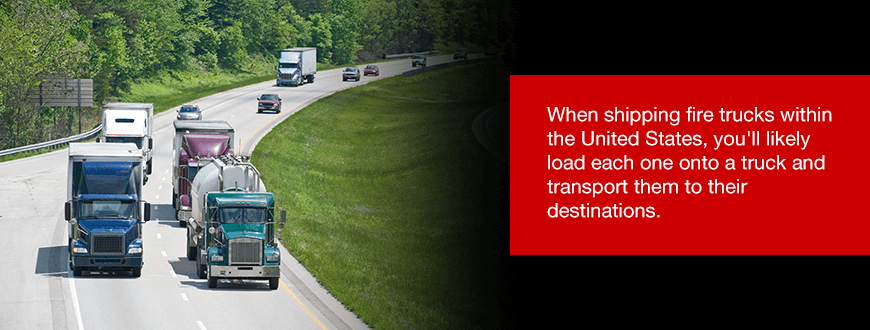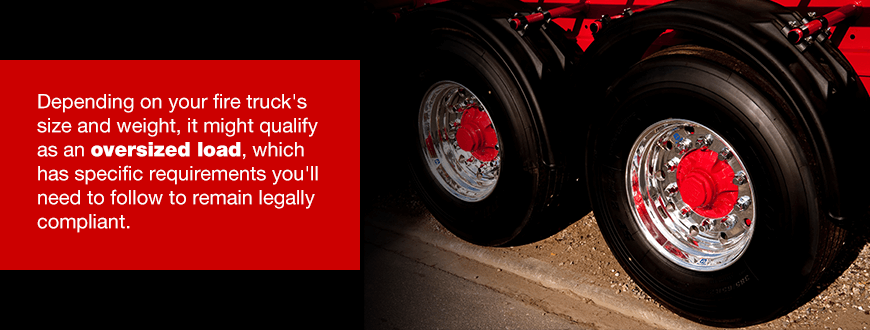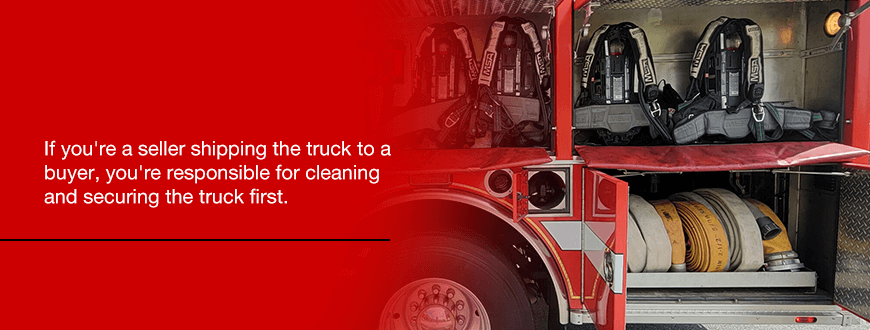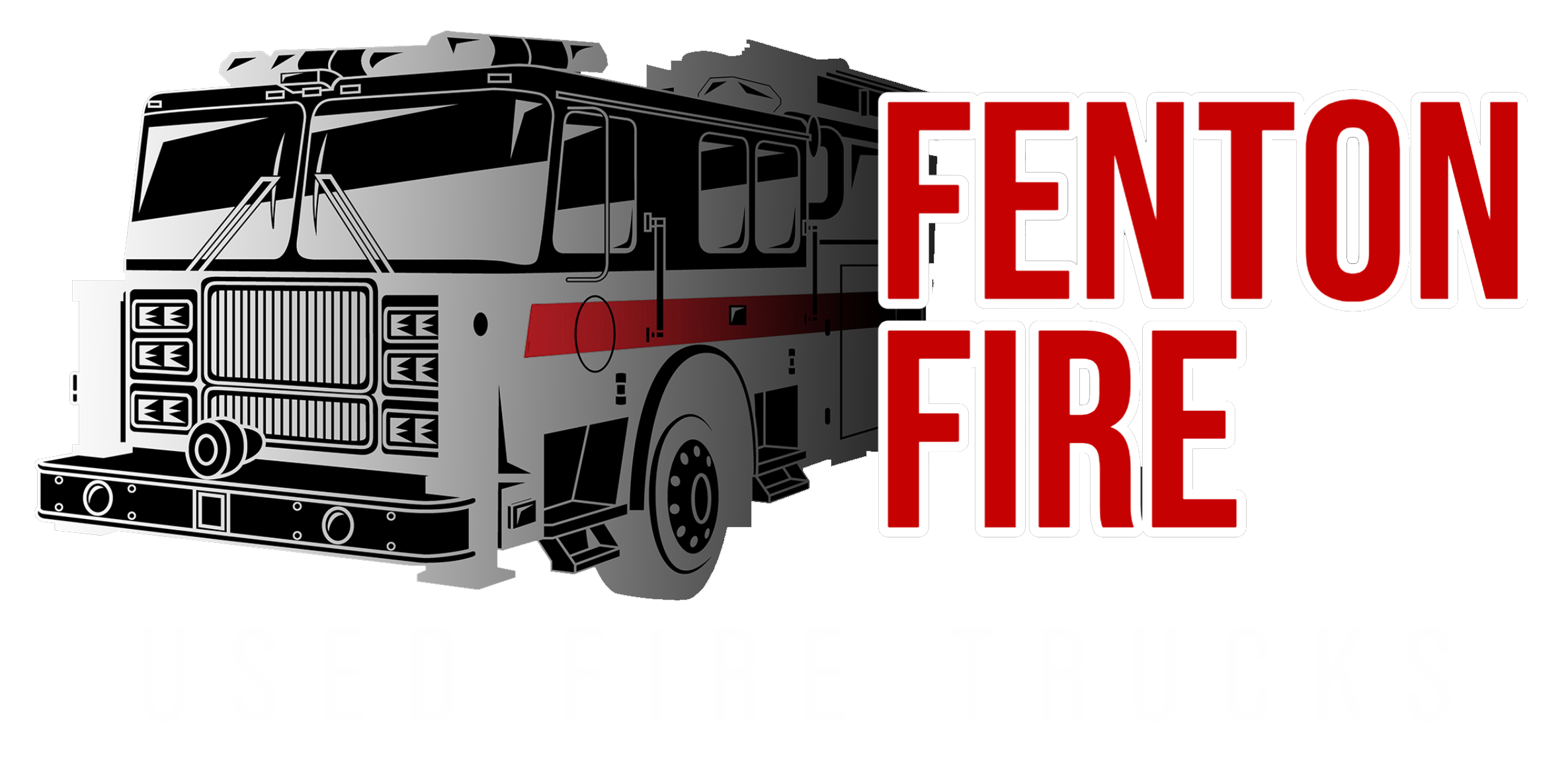Shipping a vehicle — especially one as large and intricate as a fire truck — is no small task, but it is probably easier than you’re expecting. With a little time, preparation and professional assistance, you can get your truck to your station safely, quickly and with minimal work.
If you’ve recently purchased or sold a fire truck and aren’t sure which steps to take next, you’re in the right place! Here is what you need to know about shipping a fire truck, including overseas and cross-border deliveries.
Shipping Fire Trucks Domestically

When shipping fire trucks within the United States, you’ll likely load each one onto a truck and transport them to their destinations. Most shippers use lower flatbed trucks to minimize load size and better meet state size requirements for ground transportation.
Because domestic fire truck shipping requires ground transportation, factors like the driver’s expertise, the transportation trailer’s power strength and available securing tools and equipment can determine safety and efficiency. Having the right team available throughout the process can minimize dangers and help you avoid fees and costs as you ship your fire truck.
Oversized Load Qualifications
Depending on your fire truck’s size and weight, it might qualify as an oversized load, which has specific requirements you’ll need to follow to remain legally compliant. Each state government has different standards for oversized loads, but shipments must generally be over 8.5 feet wide, 13.5 feet tall and over 80,000 pounds gross vehicle weight. Oversized loads need signs that signify their status as oversized, so other motorists can identify and navigate around them properly.

Fire truck dimensions can vary depending on their specifications and purposes. A standard fire truck typically measures 10 feet wide, 12 feet tall and 40 feet long and weighs around 60,000 pounds. However, fire trucks have many functions and come in different models. Because fire engines are smaller and lack the aerial lift that trucks usually have, they’ll be 9 feet wide, 9 feet tall and only weigh around 40,000 pounds at most.
Oversized loads require a state-certified pilot driver to lead or follow the truck. These cars help alert traffic and provide assistance to truck drivers. If you are moving a fire truck within your state, you will need to get a certification from the state government.
You might have to get multiple certifications or drivers if moving across state borders. Some states recognize the certifications of others, but this isn’t always the case. The following states only recognize oversized driver certifications from their state:
- Arizona
- Colorado
- Florida
- Georgia
- Louisiana
- Minnesota
- Nevada
- New Mexico
- New York
- Oklahoma
- Virginia
If your firetruck is over 14 feet wide or 14.5 feet high, you’ll need a second pilot car. One goes ahead of the oversized load to watch for upcoming problems, while the other guards the back and ensures everything on the truck stays safe. Lacking the right certifications, precautions and permits when transporting an oversized load can result in serious fines. Before heading out on the road to transport a fire truck, ensure you have all of the required permits for each state you’ll drive in.
Delivering Fire Trucks Short Distances
If you’re purchasing a fire truck from a buyer who is only a few cities or a state away from you, talk with them about driving the truck directly to you for in-person delivery. By driving the truck or hiring a professional driver to take the truck from the buyer to your station, you could save time and money. In-person delivery is also a good fit if you want to meet the seller or learn the ropes of your new fire truck after drop-off. Should you and the seller decide this is the best option, remember to account for the mileage, gas and wear and tear the trip will require.
It’s also worth noting that these deliveries are not usually suitable for large rigs that may require special clearance or road permits. You also lose the peace of mind that you get when working with an experienced, insured company. Because vehicle and fire truck shipping companies have short-distance and road transportation options available, you can still work with a professional service and let them handle the logistics of the shipment.
7 Tips and Things to Consider When Shipping a Fire Truck
Whether you’re selling or buying a fire truck, you need to consider several things before you begin the shipping and delivery process.
1. Work With a Professional Shipping Company
To keep shipping costs low, work with a professional shipping company that can help you choose the best method and time of year to transport your truck. Working with a professional company can help you navigate the logistics of long-distance, heavy-load shipping, as well as the different laws and regulations associated when crossing state borders and dealing with various state governments.
Before choosing a shipping company, research your options and ask plenty of questions, including:
- What warranties and safety policies do you have in place?
- Are your employees insured and bonded?
- Do you have GPS tracking available?
- Do you offer local and interstate shipping?
- How are your employees trained?
- Does your company have specific experience shipping fire trucks or similar large vehicles?
- What is your procedure if the fire truck is damaged during delivery?
Be sure to review the regulations and policies of each company you consider. Always review contracts carefully before signing and keep a copy for yourself.
2. Figure Out the Details Early
The sooner you figure out the details of your shipment, the more streamlined the process will be. Start by noting the following information:
- The size of the fire truck: You probably already know the length and weight of the fire truck you’re shipping, but make sure you have that information ready when discussing the shipment with a delivery company. The size of your rig will determine the type and cost of the shipment method.
- The shipping pick-up and drop-off locations: Consider pick-up and drop-off logistics — are you responsible for getting the fire truck to or from the nearest shipping facility, or will a shipping company pick it up directly from your home or station? Will you accept the drop-off at its destination, or will it be transferred to another delivery company?
- The timeframe of the delivery: Create a shipment schedule based on the departure date and anticipated arrival date the delivery company gives you. Allow plenty of time in your schedule for unexpected delays. If you’re the truck seller, communicate with your buyer throughout the shipment timeframe to inform them about any changes to the arrival date or location.
- What is included in the delivery: Are you shipping the fire truck only, or does the delivery include accessories like lights, sirens, gear and other equipment? Some shipment methods do not permit personal belongings inside the vehicle during shipment and may require alternative arrangements.
- What you need to do with the truck before shipment: If you’re the seller, save time in your schedule to clean, repair and service any parts of the truck that need attention before shipping it.
You should also arrange the shipment as far in advance as possible to allow for any interruptions and so you have plenty of time to seek out the most affordable and convenient options. Keep in mind that even when you’ve made your plans months ahead and are working with a top-rated shipping company, inclement weather, road closures, traffic jams and other setbacks can cause unforeseen delays in your delivery.
3. Clean and Secure the Truck Before Shipment

If you’re a seller shipping the truck to a buyer, you’re responsible for cleaning and securing the truck first. Before you begin, remove any personal or unsecured items until you’re finished cleaning and turn off the truck’s alarm system. Use warm water and an appropriate cleaning solution to wash the inside and outside of the fire truck before shipping, including:
- Attachments
- Frame rails
- Undercarriage
- Tires, wheels and rims
- Inside and outside of bins and compartments
- Hose and hose bed
- Ladder
- Pump panel
- Upholstery and flooring
- Dash panel
After the truck is dry, secure items that could move during shipments, like attachments, accessories and spare parts. Lock all doors and necessary compartments before shipping. Talk to your shipping company about the best place to transport or store the key and important documents. Consider making a copy of the key in case it gets lost during the delivery process.
4. Don’t Fill the Gas Tank
Don’t fill up the gas tank before shipment unless otherwise instructed to by a shipping company. The excess weight will add to the overall size and cost of the delivery. That said, you should consider the drop-off destination of the engine — will the buyer need to drive it off the lot? Some trailers allow fire trucks to drive onto the bed, while others pull it on using winches. If so, leave enough gas — about one-quarter of a tank full — to cover a few short trips.
5. Inspect the Truck and Make Necessary Repairs
Inspecting and repairing the fire truck before shipment keeps your buyer happy and protects your shipment. If a part of your truck is loose or already damaged, the shipment process could loosen or worsen it. A thorough inspection is also the best way to document all pre-existing damages or marks, so you have that information in case the truck is damaged during or post-delivery.
Schedule a professional inspection or perform a self-inspection of your fire truck and verify that the following parts of the truck are in good working condition, or as listed:
- Headlights, ground lights and step lights
- Radios
- Raising device
- Water pressure and flow
- Ladder and ladder control
- Engine and engine oil
- Fuel tank and filters
- Brakes
- Safety devices
- Windshield and windows
- Tire pressure and rim condition
- Battery
- Cables and fasteners
- Frame paint
- Seat condition
If you’re shipping an antique fire truck, speak with a mechanic or expert and identify areas of the truck that could be vulnerable during shipping and take extra precautions when necessary. Take note of the mileage before shipment, and don’t forget to lock all the doors and secure compartments. If you’re the buyer and recently received your shipment, inspect these same areas and inform the seller of any unlisted damages right away.
6. Take Plenty of Pictures
If you’re the seller, you probably already took pictures for your fire truck listing, but you need to take a second set of more thorough pictures before shipping your truck to the buyer. This time, photograph all areas of the truck from different angles, paying close attention to pre-existing scratches, dents, scuffs, rust or markings.
The more documentation you have of the truck’s pre-shipment condition, the easier it will be to file a claim with the delivery company or your insurance provider if the fire truck is damaged during transit.
Some areas to photograph include:
- The tires, wheels and rims
- The lights and information on the dash panel
- The window and windshield
- The interior condition of the truck
- Each side of the truck, including the bumper, hood and roof
- Existing damage
When photographing your truck for pre-shipment, be sure to take the pictures in good lighting and remove all personal objects from the truck beforehand. If your fire truck has any identifying features or abilities, like a tilt cab, photograph these in action for verification.
7. Maintain Proper Communication
When transporting a fire truck — especially long distances or across state borders — it is essential to keep an open line of communication with both the buyer or seller and the shipping company you’re working with so you don’t miss important updates or questions.
Make sure you alert the buyer or receiver of the estimated delivery time, as well as any delays and special considerations. Work with a company that confirms the delivery status along each step of the process, so you know where your shipment is at all times and can use that when communicating with your buyer, if applicable.
Should you receive the truck and notice any damage that occurred during shipment, document it with photographs and notes and compare it to the seller’s pre-shipment records and photographs. You and the seller could also arrange for a post-delivery inspection to ensure everything is functioning as it should when it arrives.
Shipping Antique Fire Trucks
Antique fire truck shipping is a little bit different from shipping a standard-use fire truck because it usually requires special considerations and a gentler touch. If it’s a preserved antique, there is also a lot more at stake in terms of shipment damage.
Some antique rigs are similar to modern fire trucks in terms of size and weight, so your shipping options are the same. If you’re transporting a small antique fire truck a short distance, you might be able to ship it using the same method you would a regular vehicle.
In addition to all regular fire truck shipping considerations, you should also do the following:
- Consider additional protection: Ask the seller to put a sunshade or blinders in the window to protect the interior paint and upholstery from fading or overheating in the sun. You can also ask them to seal any leather and add a temporary protective film to the outside of the vehicle to protect against minor scratches and scuffs.
- Let the shipping company know: If you’re working with a professional truck shipping company, make sure you let them know from the beginning that you’re shipping an antique truck. Inform them of any special considerations, like unique sizes, shapes or exterior surfaces. Try to find a fire truck shipping partner that has experience moving antique models, so they know exactly what to expect, and you have peace of mind knowing your collectible will be safe until it reaches its destination.
Talk with your insurance company before shipping an antique fire truck, as they may require additional coverage or have certain requirements to consider.
What Does It Cost to Ship a Fire Truck?
Fire truck shipping costs vary depending on several factors, including:
- The distance of the shipment.
- The weight and dimensions of the truck.
- Challenging geographies, like waterways or mountains.
- The shipping company you work with.
- The number of drivers and pilot cars needed.
- Your chosen delivery shipment speed.
- The weather, season and time of year of the shipment.
- The number or repairs you make before shipping, if applicable.
- How soon in advance you make your shipping plans.
- Destination charges, fees and taxes.
- Permits and certifications.
For example, shipping a standard size fire truck across a single state is less costly than sending a truck of the same size across the country to the opposite coast. Depending on the shipment pick-up and drop-off location, you might see higher prices during busy shipment seasons or when hazardous weather threatens shipment delays.
Some times of year are more in-demand for auto delivery, particularly summer months through early autumn because this is when many families and students move and ship their vehicles. During these peak seasons, shipping companies are more in-demand and may be more costly.
How to Minimize Fire Truck Shipping Costs
You should never sacrifice quality, insurance coverage or an on-time delivery for a lower shipping cost. Still, there are some things you can do to keep your fire truck shipment as affordable as possible. Cutting costs is especially important when working with volunteer departments, where budgets might be smaller.
Some ways to save money when shipping a fire truck are:
- Schedule your shipment months ahead of time.
- Avoid transporting your vehicle during peak months or months with bad weather.
- Shop around until you find a shipping company that has both experience and reasonable rates.
- If you’re the seller, tackle any necessary cleaning and minor repair projects yourself instead of outsourcing them.
- Choose slower shipping speeds, whenever possible.
If shipping with a company, overseas or across borders, always double-check that you are following all regulations, policies and laws set by the shipping company and border inspection to avoid fees and costly delays.
Contact Fenton Fire to Learn More About Transporting a Fire Truck
Fenton Fire helps buyers and sellers around the country connect to sell and purchase fire trucks and attachments, including antique trucks. If you’re selling a fire truck, our team of experts will even help you price and market your truck according to its unique features, make, model and condition. Once we find the right seller, we’ll let you know, and help you choose the best shipping methods and companies to work with along the way.
Listing your fire truck with Fenton Fire is also risk-free — If your truck doesn’t sell, you won’t be charged. If you’re buying a new or used fire truck, you’ll love browsing our extensive options and listings to find a truck that meets your station’s needs and budget.
Visit us online to learn more about what we can do to help you sell or purchase a fire truck or contact us for more information today!
